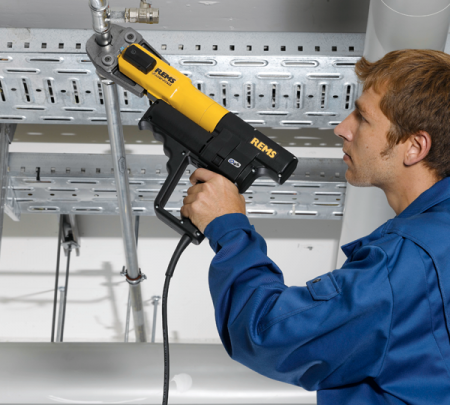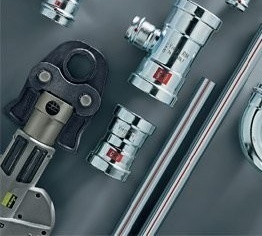Marking and technical specifications of metal-plastic pipes + hardware overview
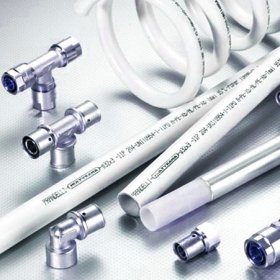
The times of unconditional domination of metal pipes have safely sunk into oblivion. They are being replaced, confidently displacing traditional analogues, plastic products come that have many advantages over metal. The concept of plastic parts is quite broad and unites a whole group of elements that are different in their properties and characteristics. In the series of such materials, metal-plastic pipes stand out a little apart, successfully combining the best properties of metal and plastic samples.
Content
What are such pipes?
A metal-plastic part is an aluminum pipe that is insulated on the outside and inside by plastic. The inner layer is a high-strength cross-linked polyethylene obtained by pressing with the participation of high pressure. It can be food, which is necessary for water pipes, or cheaper technical. Smooth plastic protects the inner surface of the pipe from possible overgrowth with scale and rust.
An aluminum core welded using ultrasound or a laser performs several functions at once. It reinforces the pipe, making it more durable and resistant to mechanical stress. The layers of polymer covering the metal on both sides do not allow aluminum to enter into chemical reactions, which protects it from destruction. In addition, this structure helps to reduce the rate of condensation on the surface of the parts and reduces their thermal conductivity. The outer layer of the metal-plastic pipe is made of a polymer that is particularly resistant to chemical influences. All layers are securely bonded to each other using special glue.
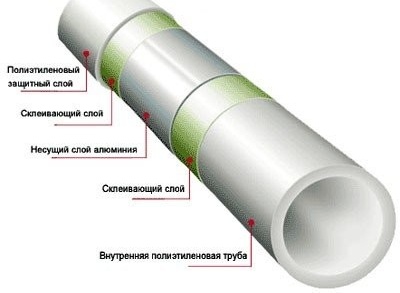
Plastic pipes are a kind of layer cake, in the middle of which there is an aluminum pipe closed on both sides with plastic
Technical Specifications
The characteristics of metal-plastic depend on the manufacturer and vary slightly. On average, these values look like this:
- The wall thickness of the parts varies from 2 to 3.5 mm.
- Products with an external diameter of 16 to 63 mm are available.
- At temperatures below 20 °, the pipes withstand pressure of about 25 bar.
- At temperatures below 95 °, the operating pressure of the elements does not exceed 10 bar.
- The service life of the products, subject to proper operation, is at least 50 years.
- The temperature mode of operation of the products is from -35 ° to + 95 °.
- Pipes are capable of absorbing noise.
- Possibility of use in drinking water supply.
- Low coefficient of hydraulic resistance.
- Gas tightness.
- Versatility in the use of products. They can be used for plumbing, floor heating, heating or cooling.
- Low thermal conductivity of parts.
- Elements are resistant to abrasion.
- Small roughness of the walls eliminates the appearance of deposits.
- High resistance to chemical influences and corrosion.
- Antistatic, parts do not conduct stray currents.
- High ductility. In addition, the bending radius of metal-plastic elements can be significantly increased provided that special bending devices are used.
Installation of metal-plastic is quite simple and economical. Above the pipes, concrete can be poured. Parts are maintainable, with no special equipment required. When installing products, it is recommended to take into account a characteristic feature of metal-plastic - various coefficients of thermal expansion of the component parts. Due to this, temperature differences can weaken the joints, which will lead to leaks. Thus, it is not possible to mount such parts in a stretch. Compensation loops are necessarily performed on the pipe bend sections.
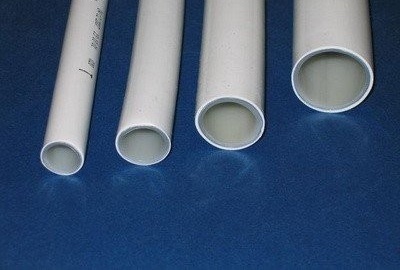
The inner layer of plastic pipes can be made of more expensive food-grade plastic. Such pipes are suitable for transporting drinking water.
How are products labeled?
Basic information about metal-plastic products and the features of their operation can be obtained from the marking of pipes. The following information is applied to the surface of the part:
- The logo of the company that released the product.
- Certificate Number of Conformity.
- Material Type: PE-X or cross-linked polyethylene, PE-R or polyethylene and PP-R or polypropylene.
- The crosslinking method used: pyroxide (a), silane (b), directed electron flux (c), nitrogen compound (d).
- Nominal pressure expressed in bars. Indicates the constant pressure at which the pipe can be operated.
- The name of the media that the part can transport.
- Lot number and production date.
Marking is applied to the pipe every meter. It can be used for precise cutting of parts. After installation, the marking can be washed off, but it is better not to do this so that it is easy to find out later which products were used for installation.

All information about plastic products can be obtained from their labeling. The figure shows an example of such marking.
Fittings for metal parts
To assemble the pipeline, fittings for plastic pipes are required. These details play an important role in the installation of the structure, because low-quality elements significantly reduce the reliability of communications. By their purpose, the details are divided into several varieties:
- Corners. Parts that change the direction of the pipeline by 45-120 °.
- Crosses. Designed to perform branches in four directions at once.
- Tees. Elements representing collectors and bends.
- Couplings. Products designed to connect pipes in a straight line.
- Adapters Parts used when connecting pipes of various diameters.
- Caps and plugs. They are used to close the ends of the pipes.
- Water sockets of various types.
- Fittings used to connect the flexible hose and pipe.
Further we will dwell on the most popular types.
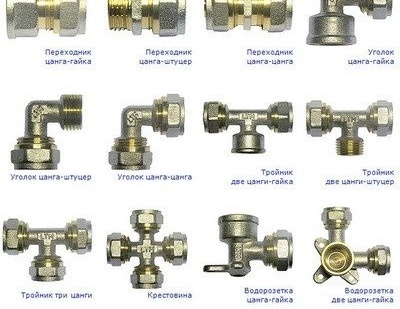
There are many varieties of fittings used for metal-plastic pipes. With their help, you can assemble a pipeline of any configuration
Collet or threaded elements
Details are connecting elements with a cylindrical thread made in accordance with GOST 6357-81. They are used to equip the tight threaded connection necessary for lengthening the line, laying additional branches of the trunk or installing various equipment on the pipe.Collet fittings provide a reliable collapsible connection that can be repeatedly removed and reassembled. This is the most expensive variety of parts. The product consists of several parts:
- Base made of specially coated brass.
- Sealing rubber gasket.
- Crimp ring.
Proper installation of the collet fitting is carried out in several stages:
- We determine the place of installation of the part, while remembering that such fittings can not be installed in areas that subsequently will not be accessible. For example, with hidden laying of a trunk in a wall or arrangement of a warm floor.
- Preparing the pipe for installation. To do this, cut it with a pipe cutter to the desired size. A slightly deformed part section is adjusted with a calibrator. We clean the butt from roughness and burrs.
- We take the fitting, unscrew the nut from it and remove the ring. We put them on the pipe.
- Install the pipe on the fitting fitting and align.
- Replace the crimp ring.
- Manually tighten the nut until it stops, and then slightly tighten it with a wrench. It is very important not to overtighten the nut, otherwise the thread will be broken and the part damaged.
The connection is ready. The disadvantages of such a system include a significant amount of time spent on the connection. In addition, it is very important to control the degree of tightening of the nut; if it is not tightened enough, the assembly will leak. The completed connection needs to be monitored during operation, since the nut may loosen over time and will need to be tightened. Detachable fittings designed for metal-plastic pipes are available in various designs. For example, a tee may have a fitting and two collets, a nut and two collets, three collets, etc.
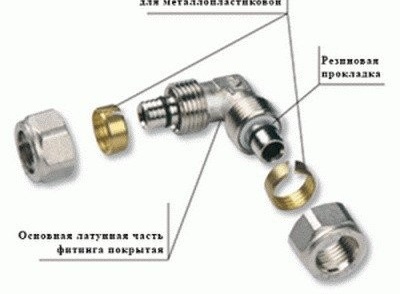
Collet elements are distinguished by the presence of a thread, which makes the connections detachable. That allows you to use parts several times if necessary
Compression or semi-detachable parts
Compression elements are used for installation and repair of metal-plastic products. They involve crimping a special crimp ring worn on the pipe, which ensures complete tightness of the parts. The main advantages of compression parts are quick and easy installation, strength and reliability of the connection, corrosion resistance and the possibility of repeated use. A wide range of products allows you to assemble a pipeline of any configuration.
The fitting consists of the following elements: a housing with a special sealing ring, a clamping ring, a nut cover and a press-in sleeve. A rubber o-ring ensures tightness of the joint even when bending the pipe. It is held in place by a press-fit sleeve. The clamping ring, made of a material characterized by high engaging properties, prevents spontaneous unscrewing of the part with possible water hammer and vibration.
The technique for making a connection using a compression fitting is as follows:
- When cutting the pipe to install the fitting, leave a length of 10 cm. The end face of the part must be processed with a calibrator.
- We twist the nut from the fitting and together with the ring we put it on the pipe.
- We humidify or lubricate the fitting with silicone grease, and then install it in place so that the end part of the pipe abuts against the edge of the fitting.
- We tighten the nut all the way, and then tighten it with a wrench.
Theoretically, a connection made using a press fitting is considered detachable. However, experts recommend replacing the part during forced disassembly, since the tightness of the connection may suffer.
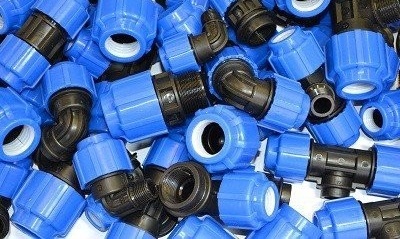
Despite the fact that the connection made using compression fittings is considered detachable, it is best not to risk and to install a new part in case of forced disassembly of the assembly
Press fittings
The connection made using such parts is inseparable, monolithic. The part consists of a copper or brass case and a sleeve made of stainless steel. The shape of the case may be different and depends on the type of connection. The sleeve provides the necessary strength. The element is crimped with a special press. After that, changing its shape is almost impossible. This is due to the special processing of stainless steel. In order to avoid the adverse effects of galvanic stray currents, a sealing ring is installed between the housing and the sleeve.
The advantages of press fittings include quick installation. In addition, such a connection is characterized by high strength and reliability. Experts recommend it for flush mounting of the pipeline. The disadvantage is the need to use special equipment during installation. These are hydraulic or manual press tongs. It is advisable to buy such equipment only in case of a large amount of upcoming work. Otherwise, it will be easier to rent a tool.
The installation process is quite simple:
- We cut pipe segments of the right size and process their ends.
- Put the crimp sleeve on the edge of the part.
- Insert the fitting.
- Using a tool, crimp the coupling.
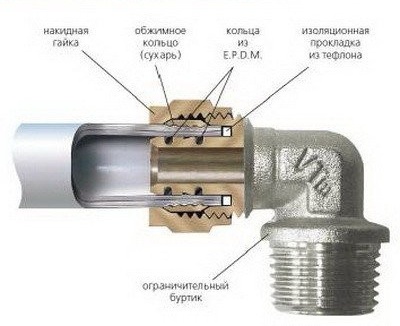
Press fittings provide a very reliable one-piece connection. Recommended for use with concealed piping
Parts for attaching products to the wall
In cases when it is required to fix it to the wall during the installation of the pipeline, special parts are used. These are clips for metal pipes, calibrated in diameter. Double and single elements are available. During installation of the product, the plastic dowel is latched into the bracket hole, after which it is inserted into the pre-prepared hole in the wall. The clips should be mounted at a distance of no more than a meter from one another, otherwise the pipe may sag.

Special clips designed for fixing metal-plastic pipes to the wall must be installed at a distance of no more than a meter from each other
Metal-plastic pipes and fittings are a practical, modern solution for arranging pipelines. A successful combination of the advantages of metal and plastic makes these products reliable, durable and at the same time quite economical. A wide range of pipes and accessories allows you to perform the line for a variety of purposes and configurations. The competent selection and installation of metal-plastic products guarantee their long and trouble-free operation.
